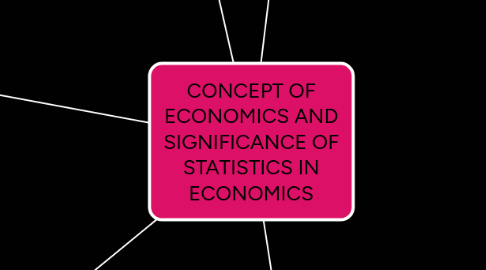
1. SCOPE OF STATISTICS
1.1. Nature of Statistics
1.1.1. Art
1.1.2. Science
1.2. Subject Matter of Statistics
1.2.1. Descriptive Statistics
1.2.2. Inferential Statistics
1.3. Limitations of statistics
1.3.1. Study of numerical facts only
1.3.2. Stdy of aggregates only
1.3.3. Homogeneity of data - and essential requirement
1.3.4. W/o reference, results may be proven wrong
1.3.4.1. Results are true only on an average
1.3.5. Can be used only by experts
1.3.6. Prone to misuse
2. FUNCTIONS AND IMPORTANCE OF STATISTICS
2.1. Quantitative Expression of economic Problem
2.2. Inter-sectoral and Inter-temporal Comparisons
2.3. Working on Cause Effect Relationship
2.4. Construction of Economic Theories & Models
2.5. Economic Forecasting
2.6. Formation of Policies
2.7. Economic Equilibrium
3. STATISTICS IS NO SUBSTITUTE FOR COMMON SENSE
4. CONCEPT OF ECONOMICS
4.1. Scarecity - The Undercurrent of Economics
4.1.1. Unlimited Wants
4.1.2. Scarce resources
4.1.3. Economic problem of choice
4.2. 3 Distinct Components of Economic Activity (plus 2)
4.2.1. Consumption
4.2.1.1. Consumer - consumr g&s for the satisfaction of her wants
4.2.1.2. Consumption - the process of using up the utility value of g&s for the direct satisfaction of our wants
4.2.2. Production
4.2.2.1. Producer - person ho produces g&s for the generation of Income
4.2.2.2. Production - converting raw materials into useful things. Things become useful as they acquire utility value in the process
4.2.3. Distribution - factors that contibute to the GDP
4.2.3.1. Land
4.2.3.2. Labour
4.2.3.3. Capital
4.2.3.4. Entrepreneurhip
4.2.4. Investment - Expenditure by producers on the purchase of such assets which help to geerate income
4.2.5. Saving - part of income which isn't consumed. Abstinance from consumption.
5. WHAT IS STATISTICS?
5.1. Definition - It referes to statistics in terms of numbers or numerical data such as Population statistics, employment statistics.
5.2. As a Plural Noun
5.2.1. Characteristics
5.2.1.1. Aggregate of facts
5.2.1.2. Numerically Expressed
5.2.1.3. Multipicity of Causes
5.2.1.4. Presence of Reasonabe Accuracy
5.2.1.5. Mutually related & Comparable
5.2.1.6. Pre-determined Objectives
5.2.1.7. Enumerated & Enumerated
5.2.1.8. Collected in a Systematic Manner
5.3. As a Singular Noun
5.3.1. Stages of statistical study: Collection, organisation/classification, presentation, analysation, interpretation
5.3.2. Statistical tools
5.3.2.1. Collection - Census & Sample Techniques
5.3.2.2. Organisation - Array & Tally Bars
5.3.2.3. Presentation - Tables, Graphs, Diagrams
5.3.2.4. Analysis - Percentages, Averages, Correlation & Regression Coefficients
5.3.2.5. Interpretation - Magnitude of Percentages, Averages and Degree of Relationship between different Economic Variables
5.4. Variables
5.4.1. Quantitative
5.4.2. Qualitative Attributes
